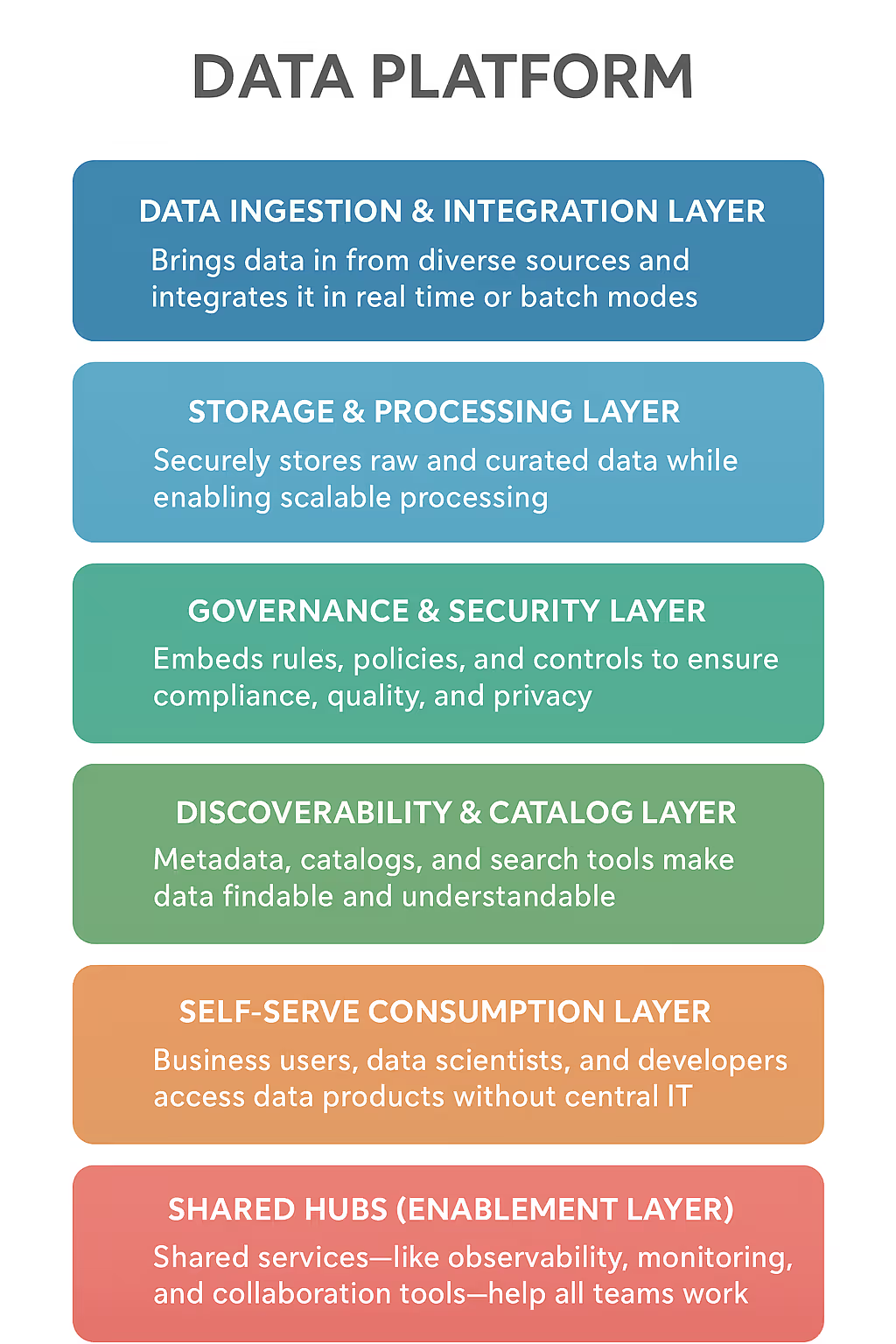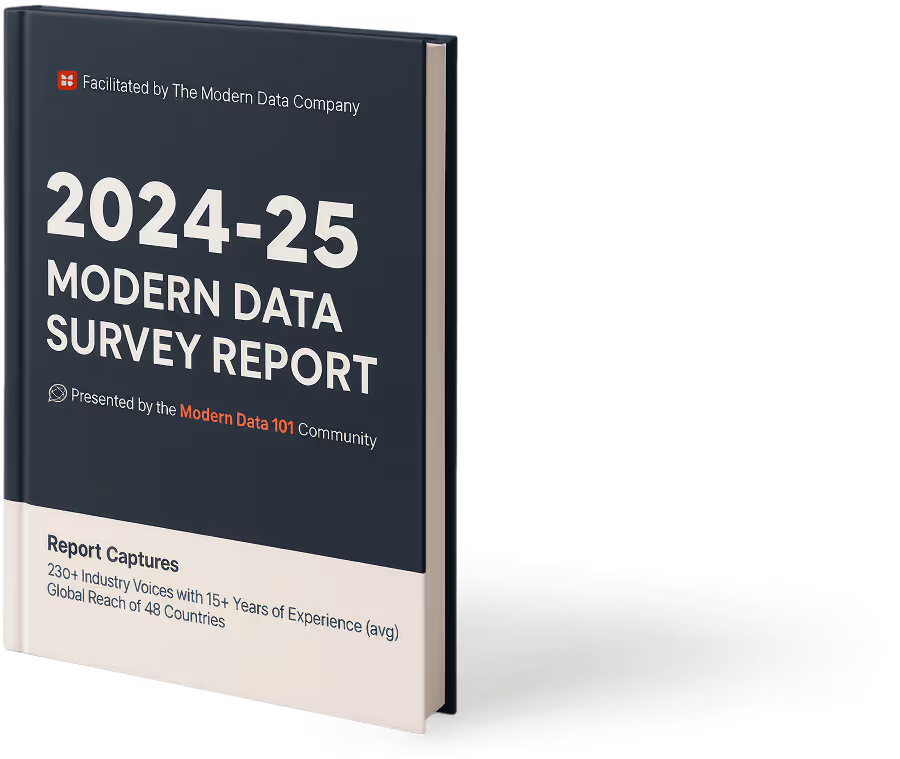
TL;DR
What is a Data Platform?
A data platform refers to the foundational layer, enabling organisations to collect, store, manage, and use data at scale. Also known as the ‘modern data stack’, it provides the right tools, infrastructure, and services needed to transform data into usable and trusted assets for apps, analytics, and AI. Learn more about the important traits needed in your data platform.
An enterprise data platform integrates multiple capabilities such as data ingestion, transformation, quality, governance, access, and security into a unified system. Fundamentally, it serves as the data’s operating system, offering teams business, analytics, data scientist and developer teams with a consistent way to boost the pace of data product creation, powering intelligent apps and insights.
Developing a robust data platform is no longer just a good-to-have avenue in today’s AI era, but a huge differentiating factor from competition, as it can generate actionable insights from data.
🎢Statistic: The Customer Data Platform market is projected to reach $23.66 billion at a CAGR of 33.9% by 2029.
What are the Benefits of a Data Platform?
A modern data platform, like we mentioned above, is more than just infrastructure, but a strategy driver to help enterprises scale, grow, and innovate with data in today’s times. It combines a robust infrastructure with a product-oriented design to deliver measurable business value while also driving teams to innovate at the same time.
Given below are some of the top benefits of a data platform:
Business Agility
High-quality, centralised data offers organisations the chance to adapt quickly and address dynamic customer requirements with shifts in the market. Teams get faster access to insights, which also reduces the lag between strategy and execution.
Cost Efficiency
When ingestion, transformation, and storage are standardised, it reduces duplication and one-off builds. It helps in lowering operational costs while also optimising cloud and infrastructure usage to drive long-term efficiency.
Revenue Growth
Data platforms turn information into a growth engine, as they enable personalisation and advanced analytics to unlock opportunities for new products, revenue models, and services.
Risk Reduction
Security, built-in governance, as well as lineage, ensure complete resilience and compliance to reduce regulatory risks while also building trust across the entire ecosystem.
Analytics and AI Enablement
An enterprise data platform speeds up the journey from raw data insights to automation, becoming a launchpad in itself to deploy AI and machine learning at scale.
Empowered Teams
Self-service access capabilities help in removing dependency on IT bottlenecks, enabling domain experts and business users to independently analyse, discover, and act on the generated datasets, resulting in domain-driven innovation.
💡Related Reads: What is Generative AI and How to Implement Gen AI for Enterprises
Data Platform vs. Data Architecture
While a data platform and data architecture are often mentioned together, they have different purposes when it comes to the modern data strategy. The following section outlines the difference between data platform vs data architecture.
- A data platform can be thought of as the operational foundation, an integrated technology system to maintain ingestion, storage, processing, access, and governance. It’s an environment where teams build and consume data products, execute analytics, and also deploy AI models.
- Data architecture, on the other hand, is a guiding framework that defines how a data product needs to be structured, governed, and linked across the organisation. It helps in setting standards, models, and principles for security, interoperability, and scalability.
If you were to think of an analogy to understand this difference better, data architecture can be the blueprint of a factory, while a data platform is the factory itself. While the blueprint guarantees safety, order, and security, the factory is the place where actual production happens.
Together, data platform and data architecture form a fabric that makes analytics, AI innovation, and data products scalable and reliable.
The Layers of a Data Platform
The modern data platform is composed of interconnected layers, with each layer addressing a crucial aspect of data management and use.

Data Ingestion and Integration Layer
As data infrastructures become increasingly complex, teams have the challenging task of ingesting data from a large variety of structured and unstructured sources. This is also known as the extraction and loading stage of ETL (Extract, Transform, Load) and ELT (Extract, Load, Transform).
This data ingestion and integration layer brings in data from different sources, such as applications, external feeds, and devices, to integrate it all in real-time or in batches, ensuring a smooth flow into the platform.
Storage and Processing Layer
A data storage and processing layer is essential as it helps teams to deal with large data volumes and stores both raw and curated data to enable scalable processing. It is the backbone layer for the entire data platform.
As companies move their data to the cloud, various cloud-native solutions have come up in the market, offering affordable and accessible options for storing data. Solutions like Databricks and Snowflake are prime examples.
Governance and Security Layer
Data governance is the practice through which organisations maintain the usability, availability, and security of data. Good governance programs help in decision-making related to the available data.
In this layer, rules, controls, and policies are embedded to ensure compliance, privacy, and quality, and provide access control, auditability, and lineage for trusted use.
💡Related reads: Learn more about the key considerations and fundamentals of governance here.
Discoverability and Catalog Layer
As data becomes increasingly complex, access to reliable data becomes a priority. In the process, the technologies under this layer need to evolve as well. In this situation, if data catalogues are the maps, data discovery is the navigation system that keeps on getting updated with the latest information and insights.
This layer consists of metadata, search tools, and catalogues, assisting in making data findable and understandable. It also reduces silos and boosts the use of reusable assets across different domain teams.
Self-Serve Consumption Layer
The self-serve consumption layer helps analysts, business users, and data scientists to access, explore, and act on data independently without depending too much on central IT teams. With intuitive APIs, interfaces, and visualisation tools, it eliminates bottlenecks and reduces time-to-insight.
Beyond simple accessibility, this layer also ensures that users are able to interact with governed and trusted data products rather than just fragmented or raw datasets. It combines usage ease with built-in quality controls, as well as lineage and compliance, opening room for safe experimentation and dependable decision-making.
Shared Hubs (Enablement Layer)
The shared hubs layer in a data platform offers various standard services, such as observability, monitoring, workflow automation, and collaboration, that support each team using the platform. When these capabilities are standardised, organisations reduce duplication and enable consistent domain practices.
This layer can also be considered as the connective tissue for the platform, ensuring that teams can work autonomously as they stay aligned with enterprise standards.
Primary Data Platform Features
Today’s enterprise data platform has become so much more than a collection of technologies, built on the fundamental characteristics to ensure data that can be trusted, shared, and effectively used across the entire organisation.
Some of the critical data platform features are as follows:
- Self-Serve
A data platform is designed for autonomy, empowering teams to access and use data without relying on any external ‘gatekeepers’, fostering innovation and agility much closer to the point of creating actual business impact. - Accessibility
Data needs to be equally accessible across various domains, roles, and geographies. When silos are removed, the platform offers a single and trusted foundation for offering collaboration at scale. - Discoverability
When data is treated as a product, it ensures that assets are well-documented, findable, and simple to understand. Metadata, catalogues, and search make this discovery seamless. - Domain-Aligned Governance
Governance is consistent, even with its federated approach, helping to balance local ownership with standards set across the enterprise. It ensures quality and compliance without creating bottlenecks. - Scalability and Resilience
Designed with both the present and the future in mind, an enterprise data platform should be able to handle dynamic and large workloads while also ensuring security, uptime, and performance.
How to Choose the Right Data Platform?
Choosing a modern data platform is a strategic decision that defines how enterprises use data to fuel efficiency, innovation, and growth. The first step is to finalise the business outcome, which can range from unlocking new business avenues to enabling AI at scale. Such a platform should allow measurable value, and not just technical capabilities.
The next step would be to assess maturity requirements. While some organisations may prioritise control and governance, others may give more importance to self-serve access and agility. In the line of assessments, vendor lock-in risks are another element to be put into consideration, where interoperability is key to long-term durability.
Amidst all this, AI-readiness becomes another important factor when choosing a data platform. It should be able to expose data products in a way that AI models and agents can consume easily, ensuring that enterprises are successful in navigating with intelligent automation as a core premise.

Key Takeaways
A modern data platform is a lot more than just infrastructure. It’s a foundation to encourage agility, AI-driven innovation, and governance. With a combination of ingestion, governance, storage, discovery, and self-serve layers, teams are empowered to create reusable and trusted data products.
When choosing the right option, organisations should give weightage to metadata, interoperability, domain alignment, and AI-readiness. In the present world of AI, a resilient, scalable, and discoverable data platform is crucial to transform data into a driver of business value.
Frequently Asked Questions (FAQs)
1. How does a data architect design the platform?
A data architect designs a platform with the following steps: defining the blueprint for data flow, governance, and structure. This ensures interoperability, scalability, and security while also getting a proper data platform strategy. A data architect’s role acts as a bridge between strategy and implementation.
2. What is a CDP?
A CDP (Customer Data Platform) is a specialised data platform that unifies customer data from multiple sources into a single, accessible view. It offers personalisation, AI-driven marketing, and analytics by making data discoverable, actionable, and well-governed. With real-time insights, CDPs drive businesses to improve retention and engagement with data-driven insights.
3. What is data architecture?
Data architecture refers to a strategic framework to define how data is collected, integrated, stored, and governed across an enterprise. It helps in determining policies, models, and standards to ensure compliance, quality, and scalability. While a data platform is the technology stack, data architecture is the blueprint to trusted ecosystems.



Author Connect 🖋️

Simran Singh Arora

Simran is a content marketing & SEO specialist.
Simran is a content marketing & SEO specialist.




%20(1).png)






